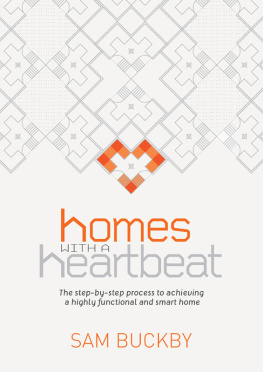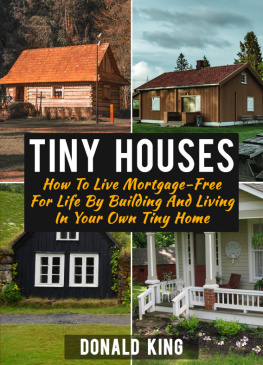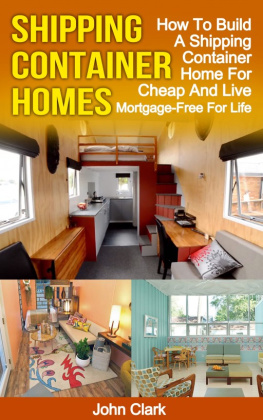
Smarter Buildings by Sam Buckby
PO Box 5022 East Geelong
Victoria 3219
www.smarterbuildings.com.au
First published in 2015 by Sam Buckby
2015 Sam Buckby
The moral rights of the author have been asserted.
All rights reserved. Except as permitted under the Australian Copyright Act 1968 (for example, a fair dealing for the purposes of study, research, criticism or review), no part of this book may be reproduced, stored in a retrieval system, communicated or transmitted in any form or by any means without prior written permission. All enquiries should be made to the publisher.
National Library of Australia Cataloguing-in-Publication entry:
| Creator: | Buckby, Sam, author |
| Title: | Homes with a heartbeat: the step-by-step process to achieving a highly functional and smart home |
| ISBN: | 9780994343352 (paperback) |
| ISBN: | 9780994343369 |
| Subjects: | Functionalism (Architecture) |
| Architecture, Domestic |
| Dewey Number: | 728 |
Cover design by Adam Kelly, SIXTWO CREATIVE
Interior design by Michael Hanrahan Publishing
Printed in Australia by McPhersons Printing
ABOUT THE AUTHOR
Sam Buckby is the owner and founder of SmarterBuildings by Sam Buckby. He is also a registered electrical contractor and has been the managing director of a successful electrical company for over ten years. Most importantly, he is a husband, a father and a huge advocate for the importance that our home plays in so many facets of our lives. He honestly believes that having a home aligned with the people within is one of the most important ingredients to loving life in general.
When Sam was young he would often sit beside his dad and watch in awe as his dad would sketch up future house plans, possible renovations or even backyard jobs on a well-used notepad. His dad, however, is no architect or draftsman or builder. What he was then and remains to be today is just a great dad. In this period of time his dad, Robin, worked three jobs for up to 16 hours a day, six days a week. Yet somehow he still always found the time to attend school events, coach the soccer team and teach his boys everything they needed to know to become young men.
When Sam was seven his family moved from South Australia across the border, where his entire adolescence and the first half of his twenties was spent in the little coastal towns of Queenscliff and Point Lonsdale on Victorias south coast. Life was humble and really all about the beach, the footy club and his mates. Until he met that girl
Fast forward to now and Sam resides in the beautiful city of Geelong with his wife Tenielle and his three kids Grace, Hugh and Adelaide. They still live in their first home. A home that when purchased needed a bit of work. Ironically, Sam spent the next six or so years sketching up future house plans, possible renovations and sometimes even backyard jobs ready for the weekend ahead. Sam was also busy running a business, sometimes up to 16 hours a day but never missing his childrens events or milestones.
Perhaps the apple didnt fall far from the tree, but this home is now renovated and Sam and his family love it. The home is beautiful, but more importantly it is highly functional, absolutely aligned with the family and, above all, simple to use. For Sam this meant he hit every one of the four corners of his lifes intersection in one building. Family. Functionality. Simplicity. Home.
These paradigms now shape all Sams future aspirations, including his quest to constantly merge technology with construction, designing smarter buildings and, ultimately, creating Homes With A Heartbeat.
CONTENTS
THANKS TO
Tenielle; I never knew how much you were going to change me for the better until it happened. Too much love.
Grace, Hugh and Adelaide; you give me a reason to jump out of bed everyday excited about whatever comes next.
Adam, Jacqui and Michael for your ripping help and support in design, editing and publishing.
The KPI gang, especially GC, AG, DD and crew. You rock.
And my inspiring and constantly motivating friends (you know who you are); keep pushing. I love it.
Step 1
WHERE ARE YOU NOW?
Every building has a unique starting position. Whether its a home, office, school or garden shed, there are certain necessities that need to be factored in and assessed to determine the best course of action in a design.
Whether you want to help the environment, cut costs, or improve your lifestyle, you probably already have some ideas on how youd like to turn your home into a Smart Home. However, if you arent clear on where you are now, how will you know where to go?
Just like giving someone directions to your house is very different depending on whether theyre starting in an adjacent suburb or a different city, the steps required to create your Smart Home will be different based upon your starting point. Otherwise, you could end up investing your time, money, and energy in gadgets that might not work or you might not need.
But what most people do is, rather than reviewing their starting point and thinking holistically about how they really want their home to improve their lives, react to an isolated problem or complaint with an isolated product or solution.
As an example, one of the more prominent problems is our reaction to extreme heat and cold. Too often this causes a haphazard, spontaneous purchase that lacks research and sometimes even logic.
Ive spent most of my life on the south coast of Victoria, Australia. Down there at the reasonably southern latitude of 37 we get a huge range in weather and, more specifically, temperature. We experience extreme changes not only throughout the week, but also within a single day. It is common in the early autumn months of March and April to experience cold, almost wintery temperatures, as well as 40+C in the space of 48 hours. In the summer months, strings of these hot days will sometimes occur, and this is when people tend to make irrational, illogical decisions regarding their climate and comfort.
What tends to happen is, without any research or investigation, the homeowner contacts an air conditioning installer to organise a cooling unit to be installed as soon as humanly possible! The question often asked over the phone by the so-called professional is How big is the room?, to which the home owner responds Oh, I dont know, maybe five metres long and the same wide. The installer selects a unit to service an area of about 25 square metres and lets the owner know the approximate price. The homeowner, sweltering in the extreme temperature, quickly agrees for an install the very next day.
You may think this is pretty good service. The installer has agreed to a prompt next-day service, but is this service really going to be valuable? The homeowner has now committed to investing $3000 to $5000 to cool just a room or two.
The problem in this scenario is that the room was hot and the customer wants it cool. Seems logical, doesnt it? Now, there is no doubt this cooling unit will indeed do its job of cooling. But will it be as effective as it could have been, had they considered their starting point?
Lets allow that the homeowners estimate of the room being five metres by five metres is correct. They also need to consider many other factors to get the best results, including:
- How high are the ceilings, so we can calculate the actual space we are trying to cool?
- Does this room close off to other areas or is it open-plan, incorporating other liveable spaces of the home?
Next page











